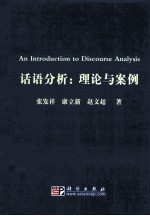

话语分析 理论与案例PDF电子书下载
- 电子书积分:10 积分如何计算积分?
- 作 者:张发祥,康立新,赵文超著
- 出 版 社:北京:科学出版社
- 出版年份:2009
- ISBN:9787030233417
- 页数:210 页
Part One Discourse Analysis Theory 3
Chapter 1 An Introduction to Discourse Analysis 3
1.0 Introduction 3
1.1 Definition of discourse 4
1.2 Discourse analysis:its definition and development 7
1.3 "Text","context"and"discourse" 11
1.4 An understanding of DA as a discipline 13
1.5 Conversation analysis and conversational principles 15
1.5.1 Conversation analysis 16
1.5.2 Conversational principles 19
1.6 Eclecticism in discourse analysis 23
1.7 DA and pragmatics 27
Chapter 2 Methodology of Discourse Analysis 29
2.0 Introduction 29
2.1 Methods of doing discourse analysis 29
2.1.1 Structural discourse analysis 30
2.1.2 Socio-cultural discourse analysis 30
2.1.3 Cognitive discourse analysis 31
2.1.4 Critical discourse analysis 31
2.1.5 Integrated discourse analysis 34
2.2 Understanding the methods 34
2.2.1 In terms of focus 35
2.2.2 In terms of aim 36
2.2.3 In terms of technique 38
2.3 Summary 40
Chapter 3 Theoretical Thoughts about Discourse 41
3.0 Introduction 41
3.1 Speech act theory 42
3.2 Cooperative principle theory 46
3.3 Face and politeness principle theory 49
3.4 Relevance theory 53
3.5 The study of stylistic variation and registers 56
3.6 Schema theory 59
3.6.1 The terminology of schema theory 61
3.6.2 Evidence for schemata 63
3.6.3 The origins of schema theory 66
3.7 Post-structuralist theory about discourse 67
3.7.1 Michel Foucault's thoughts about discourse 70
3.7.2 M.M.Bakhtin's dialogic view on discourse 73
3.8 Genre theories 76
3.8.1 The problem of definition 76
3.8.2 Definitions in applied linguistics 78
3.8.3 Systems of genre studies 81
3.9 Summary 93
Chapter 4 Discourse Analysis and Second Language Teaching 95
4.0 Introduction 95
4.1 Application of discourse analysis to grammar teaching 97
4.2 Application of discourse analysis to vocabulary teaching 99
4.3 Application of discourse analysis to text interpretation teaching 101
4.3.1 Top-down and bottom-up text processing 102
4.3.2 Types of text 103
4.3.3 Patterns in text 104
4.4 Application of discourse analysis to conversational interaction teaching 105
4.5 Summary 108
Part Two Cases Analysis 111
Chapter 5 Discourse Types 111
5.0 Introduction 111
5.1 News discourse analysis 111
5.1.1 Vocabulary analysis 112
5.1.2 Word features 117
5.1.3 Syntactical analysis 119
5.2 Public discourse analysis 120
5.2.1 Modal verb analysis 121
5.2.2 Analysis of pronoun 122
5.3 Advertising discourse analysis 125
5.3.1 Lexical features 126
5.3.2 Syntactic features in advertising discourse 144
5.3.3 Rhetorical features in advertising discourse 147
5.4 Diplomatic discourse analysis 152
5.4.1 Forms of achieving vagueness in diplomatic discourse 155
5.4.2 Functions of vagueness in diplomatic discourse 161
5.5 Teacher-student discourse analysis 163
5.5.1 Elements of structure in classroom interaction 164
5.5.2 Classes of acts 167
5.5.3 Classes of moves 168
5.5.4 Classes of exchanges 170
5.6 Humorous discourse analysis 172
5.6.1 Remarkable characteristics of humor 174
5.6.2 Cooperative principle and humor 175
5.6.3 Speech act and humor 178
5.7 Network discourse analysis 179
5.7.1 Reasons for the formation of network discourse 180
5.7.2 Development of network discourse 181
5.7.3 Classifications of network vocabulary 182
5.7.4 Characteristics of network discourse 188
References 197
- 《水面舰艇编队作战运筹分析》谭安胜著 2009
- 《SQL与关系数据库理论》(美)戴特(C.J.Date) 2019
- 《联吡啶基钌光敏染料的结构与性能的理论研究》李明霞 2019
- 《国家社科基金项目申报规范 技巧与案例 第3版 2020》文传浩,夏宇编著 2019
- 《情报学 服务国家安全与发展的现代情报理论》赵冰峰著 2018
- 《分析化学》陈怀侠主编 2019
- 《英汉翻译理论的多维阐释及应用剖析》常瑞娟著 2019
- 《新课标背景下英语教学理论与教学活动研究》应丽君 2018
- 《党员干部理论学习培训教材 理论热点问题党员干部学习辅导》(中国)胡磊 2018
- 《虚拟流域环境理论技术研究与应用》冶运涛蒋云钟梁犁丽曹引等编著 2019
- 《指向核心素养 北京十一学校名师教学设计 英语 七年级 上 配人教版》周志英总主编 2019
- 《《走近科学》精选丛书 中国UFO悬案调查》郭之文 2019
- 《北京生态环境保护》《北京环境保护丛书》编委会编著 2018
- 《中医骨伤科学》赵文海,张俐,温建民著 2017
- 《美国小学分级阅读 二级D 地球科学&物质科学》本书编委会 2016
- 《指向核心素养 北京十一学校名师教学设计 英语 九年级 上 配人教版》周志英总主编 2019
- 《强磁场下的基础科学问题》中国科学院编 2020
- 《小牛顿科学故事馆 进化论的故事》小牛顿科学教育公司编辑团队 2018
- 《小牛顿科学故事馆 医学的故事》小牛顿科学教育公司编辑团队 2018
- 《高等院校旅游专业系列教材 旅游企业岗位培训系列教材 新编北京导游英语》杨昆,鄢莉,谭明华 2019
